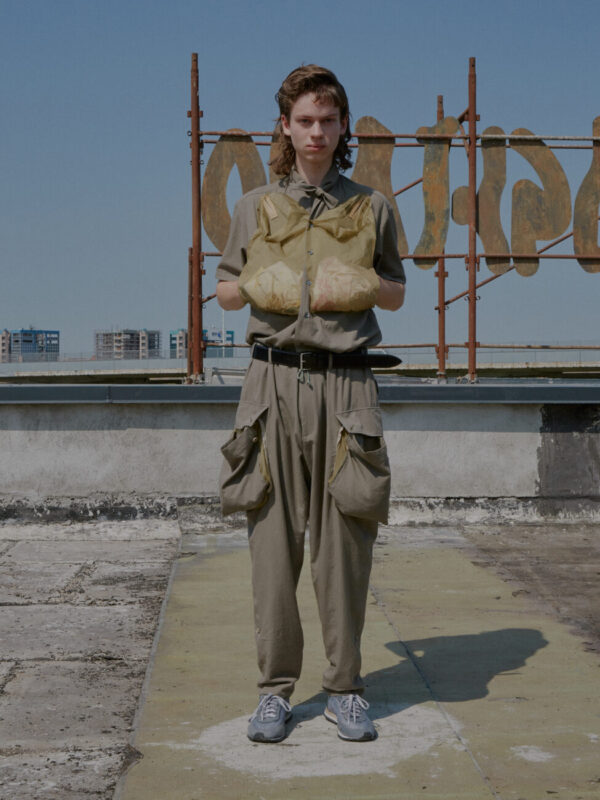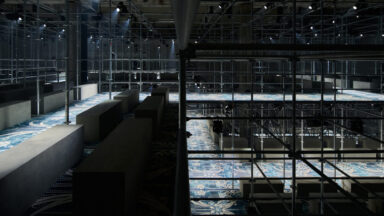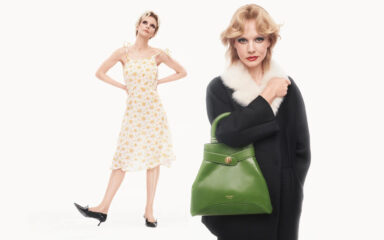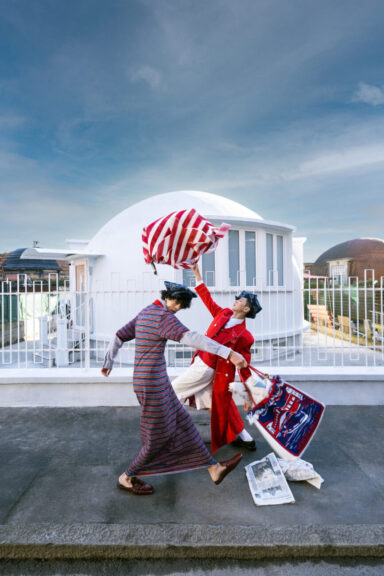Under a hot Milanese sun, the city’s brands have come to life with offerings for S/S 2023 that channel an escapist mood and propose a multiplicity of ways of dressing for the season ahead. Among them, a juxtaposition of archetypal menswear garments at Prada, Dolce & Gabbana’s noughties re-editions, JW Anderson’s much-anticipated debut in Milan and Magliano as an auteur film
Words DOMENICO COSTANTINI
44 LABEL GROUP
For its Milan Men’s Fashion Week debut, 44 Label Group presented its ‘Full of Fire’ collection, a product of German techno artist and producer Max Kobosil. The designer’s creative background was evident in the collection’s concept, which revolved around the refusal to be labelled by others and the forming of new paths made through positive emotions.
This could be seen in the disassembled, raw-edged and layered garments that ran through the entire line of genderless silhouettes. The t-shirt, considered the core force for the brand, was at the centre, and stood alongside trousers, shorts and skirts each in conflicting materials. Many pieces drew inspiration from a utilitarian attitude, contrasting torn details, over-dyed printing and 3D embroidery.
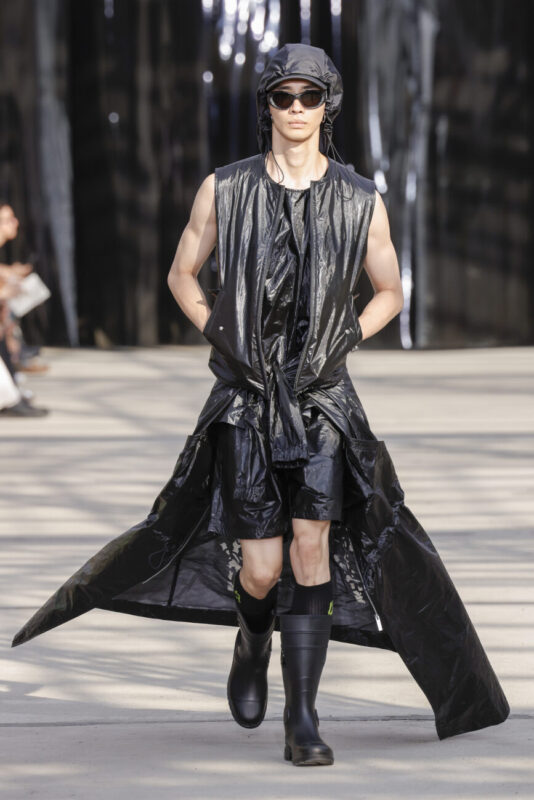
DSQUARED2
Dean and Dan Caten looked towards the surfer for inspiration for their latest collection, mashing up the archetype with their own brand of glamour and flash. Eclectic layering – as if the various items of clothing were picked up on travels around the world – was the collection’s hallmark, whether a colourful sarong tied over a studded jean, a Honda-branded biker jacket with shorts and flip flops, or a colourful array of jumpers tied around the waist (prints were equally eclectic, from block-printed turtles to various New Age motifs). Elsewhere, the duo paid ode to musician Bob Marley, uniting with the late artist’s foundation, his face used as a motif across outerwear, shoulder bags and T-shirts – the latter worn by the duo to take their bare-footed bow.
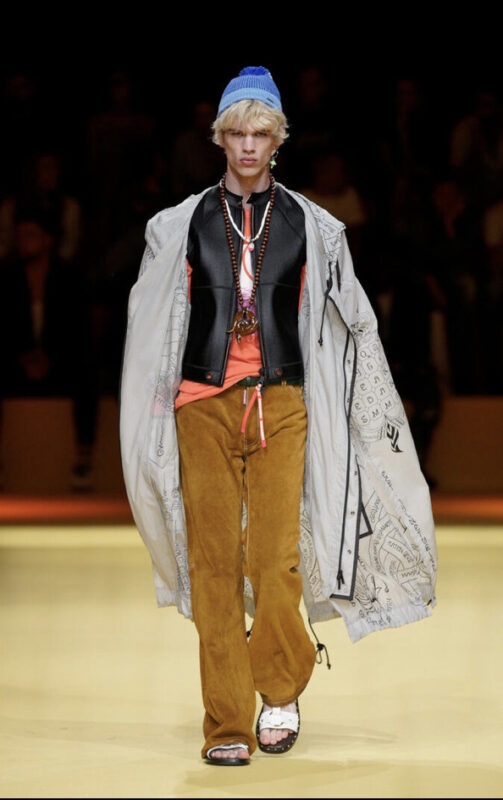
EMPORIO ARMANI
Giorgio Armani noted that this season he was thinking about the idea of lightness, not simply in the collection’s texture, but also in the conception of a wardrobe which encapsulated the freedom of dressing for the summer months – ‘the sheer joy of dressing for the season: choosing clothes and accessories to thrown on without too much thought’. Ease, therefore, defined the season’s offering, communicated through riffs on the garments. The desire was to create pieces which barely touched the skin – loose-fit tunics, unstructured tailoring, details which included ties, slits, openings and cuts – allowing the body to breathe. Around the showspace at Armani/Teatro was a woven motif reminiscent of a basket; Armani noted that he sees Emporio as ‘a container of possibilities’, here providing a gamut of carefree looks for the year’s warmest months. Or, ‘a basketful of summer,’ as the house described.
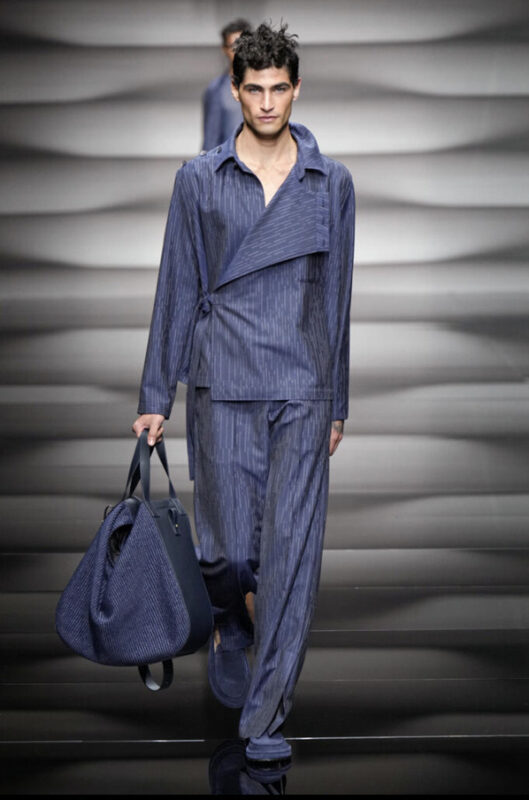
MARCELO BURLON COUNTRY OF MILAN
Marcelo Burlon’s 10th anniversary show opened on a high note as 1998 dance hit “Free” by Ultra Naté boomed from the speakers. “You’re free, to do what you want to do,” the American artist sang. Burlon has always obliged, following his own instinct, for good or bad. This show, held at Velodromo Vigorelli, celebrated just that and cast 50 characters, including a few models and several friends of the brand. Streetwear references echoed in the California skater’s Bermuda shorts with ribbed tank tops and hooded parkas, the cotton overalls and paratrooper’s suits. Patchwork shawl-collared sets had a folk inflection and came with raw-hemmed panels or mixing checks, ikat and animal prints. The feather motifs that made him famous a decade ago framing T-shirt collars drifted onto deconstructed jackets and loose pants. Tie-dye motifs captured the hippy vibe of some earlier displays, while knitwear was just too cool to go unnoticed. Toward the end of the show, the designer, clad in a blue leather workwear suit, as a faithful companion.
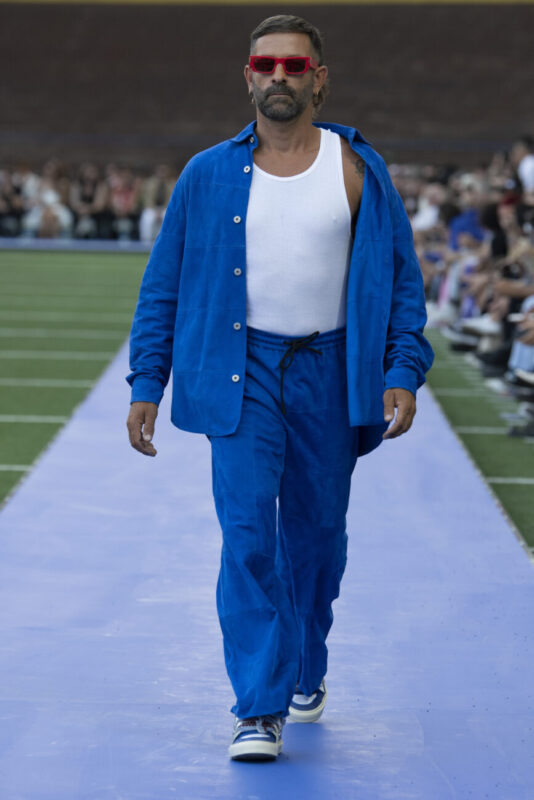
PRADA
A paper-white set, evocative of the walls of a house, replete with giant windows and crisply folded gingham curtains, provided the backdrop for Miuccia Prada and Raf Simons’ latest collection (in keeping with the theme, guests, including current campaign star Jeff Goldblum, sat on stools crafted from cardboard). The collection itself, titled ‘Prada Choices’, was centred on the act of curating one’s own style – ‘the juxtaposition of elements and garments, fashioning an impression, creating style’. As such, the designers looked towards archetypal menswear garments – among them the suit and mackintosh jacket – and fabrics, like denim and leather. They noted that the collection’s energy came from shifts and juxtapositions; the classic suit sat next to a mini leather short and matching vest, for example, and discrete four-button overcoats next to stone-washed double-denim. The garments are classic, but their mix contradicts, making them exciting and new.
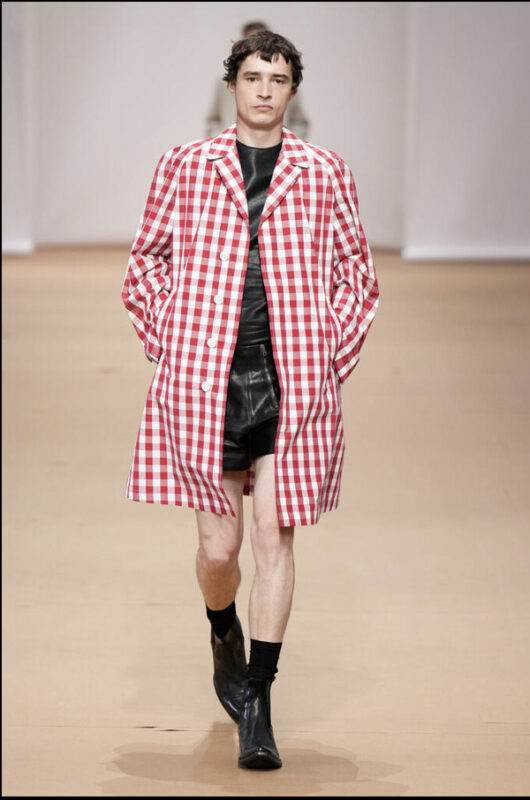
DOLCE & GABBANA
A journey into the Dolce & Gabbana archive provided the starting point of a collection which saw items of clothing from the brand’s history, reworked from the years 1990-2000 return to the runway, alongside contemporary looks designed in the same spirit. As such, the collection had the undone feel reminiscent of the eras referenced, completing a vision for the season where past and present intertwined.
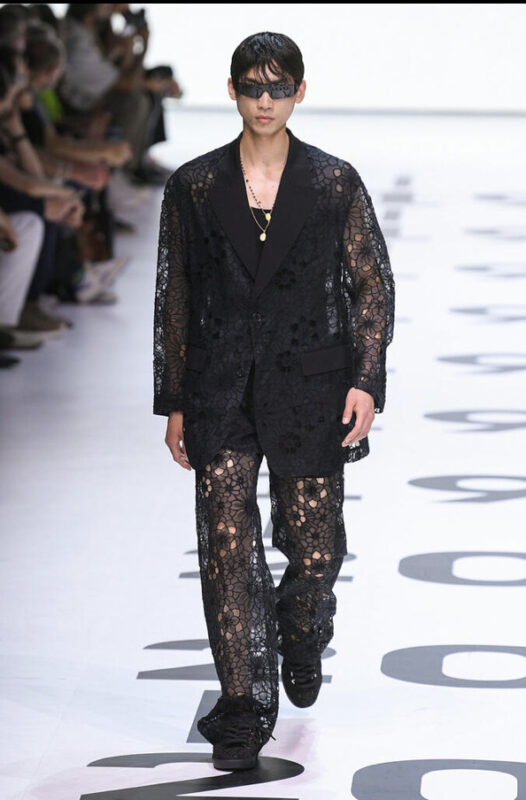
JW ANDERSON
Great wait to the Milan schedule was British designer Jonathan Anderson, who brought his eponymous label to a warehouse in the city’s north-east. It is part of a plan to transport JW Anderson to various locations in coming seasons; here, this demonstrated the freedom such an approach can allow a designer, with Anderson positing a conceptual offering that began outside, models lounging on white plinths in the space’s entryway (their various, mostly-knit clothing was emblazoned with slogans like ‘see here at last is love’). Inside, garments had a playful – like in Duchamp’s archetype: bicycle handlebars and broken skateboards were strapped across the chest, T-shirts inset with the opened lids of tin cans, and barcodes peeked out from beneath torn-away denim jackets and trousers. Accessories were also joyfully idiosyncratic: bouncing slides covered in shimmering crystals, slip-on sneakers decorated with a self-portrait by Rembrandt – a print that also adorned boldly hued sweaters. The collection notes called the meeting of these disparate elements a ‘crash’ – ‘it is all very subjective, and rather puzzling, or defiant, or insolent’.
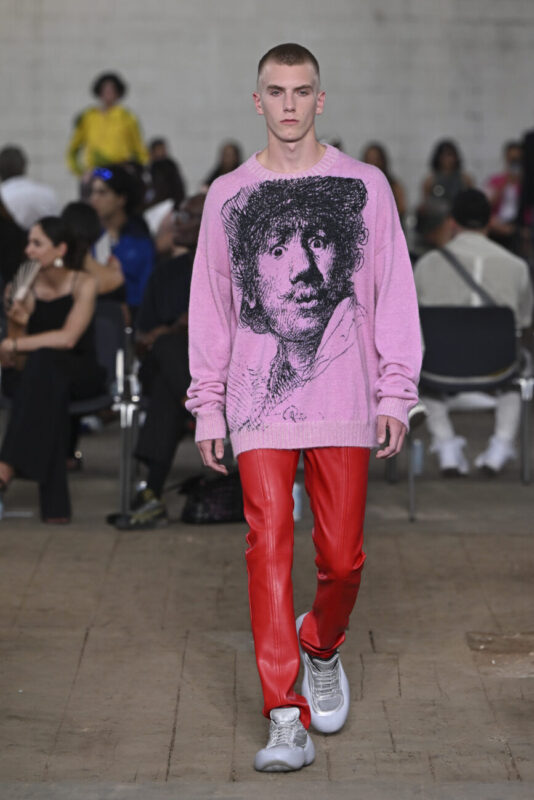
ZEGNA
Upholding an innovative and ethically responsible spirit, Sartori puts a progressive spin on the contemporary wardrobe and brings practicality and pragmatism to the forefront. The ZEGNA Fashion Show begins in the birthplace of the brand, Oasi Zegna, the free-access natural territory sprawling 100 km2 across Piedmont, Northern Italy. Made of progressive values and ideas, this historic path is a powerful inspiration for Artistic Director Alessandro Sartori, and the new iconic double-stripe brand mark featured throughout. Envisioned in the form of a film, Sartori’s conceptual runway transports the viewer from great outdoor scenes in Oasi Zegna to abstract interiors, while always showcasing a directional path forward. The presentation culminates in a celebration of human bonding, featuring an exclusive performance from esteemed choreographer Sadeck Waff, envisioned as a symbol of the 160 talented artisan hands that crafted the new collection.
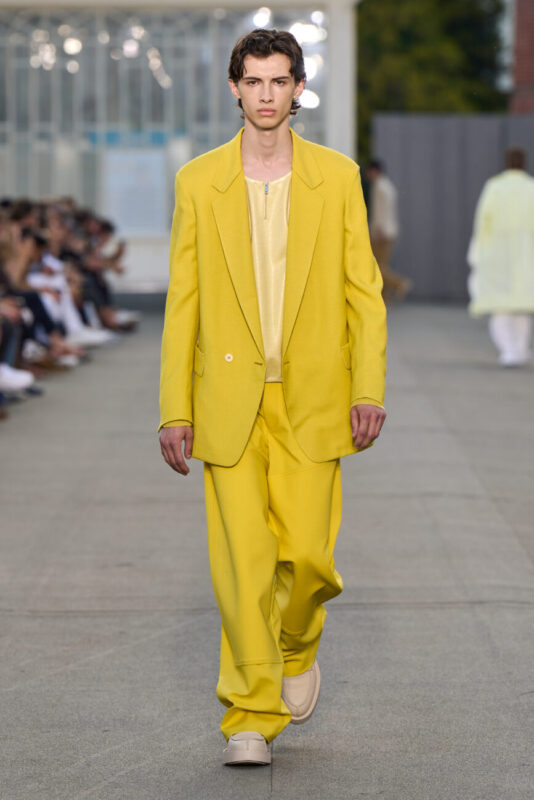
MAGLIANO
It was something very magical, a tracing of the highest neorealist directors. We must not add unnecessary qualunquisms, but simply follow the script: “A long and exhausting night comes abruptly to an end. It is followed by the dawn, soft and gentle, then intense and bursting in and illuminating, lighting up, without asking permission. How sweet is the awakening Darkness embraces, conceals, soothes. It is sensual, sexual, erotic. It is mysterious. It is drunk, like the jackets deconstructed, disassembled and then reassembled with recycled scarves knotted loosely around the jackets themselves. The lace and linen pajama suits are sexy and essential, their shapes simplified, synthetic, almost minimal. The garments wrap, they ask: can clothes heal wounds? The answer is uncertain and goes through the prints inspired by antiretroviral drug therapies. The awakening is sudden, confusing, overwhelming. The light blinds and only outlines are visible. Silk organza combines with cotton, sometimes overlapping freely, to speak of the inescapable themes of work, the workshop, the working world. The effect is a penumbra on the clothes, a ghostly surface that exaggerates the silhouettes of the garments and is lost in the play of light created in the exhibition venue, a disused fifty-year-old Enel high and medium voltage transformer cabin. A memory melancholically resurfaces as a souvenir of a happy moment. Hawaiian shirts are a tribute to faraway places, talismans of joy, shirts made of old shirts that recall memories of an uncertain past. The collection is fluid, rough, wrinkled. Inside those garments, someone dreamed there.”
